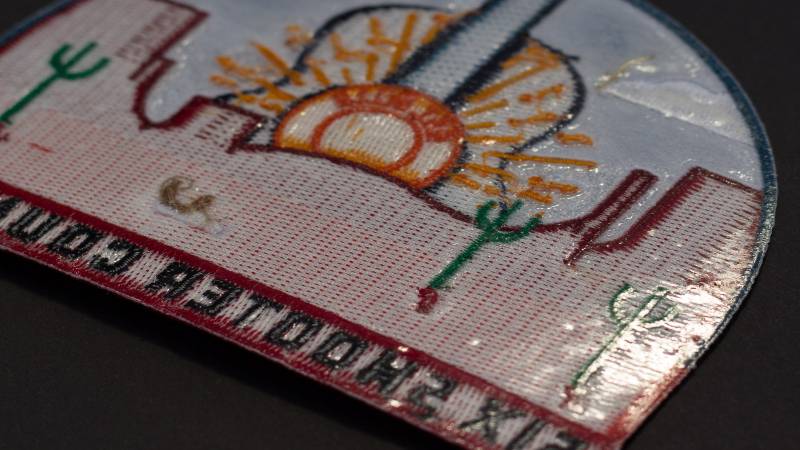Washable Iron-On Patches: Care, Durability and Heat Seal Tips
This article is your go-to resource for everything you need to know about keeping those iron-on patches looking their best, even after countless washes. Whether you’re a small clothing business owner looking to advise your customers on garment care, or you’re just starting out and want to ensure your own branded apparel lasts, you’ll find practical, expert-backed advice here.
We’ll dive into the science behind iron-on patch adhesion, the best fabrics to use, a step-by-step washing guide, troubleshooting tips, and long-term care strategies. By the end of this guide, you’ll have the knowledge to keep your iron-on patches vibrant and securely attached, wash after wash. Let’s read!
1. Understanding Iron-On Patches and Washability
1.1 What Makes Iron-On Patches Washable?
Iron-on patches rely on a heat-activated adhesive – essentially a special type of glue – to bond to fabric. This adhesive is typically made of a polymer or resin that melts when heated, allowing it to seep into the fibers of the fabric. Think of it like a hot glue gun, but specifically designed for textiles. When the adhesive cools, it solidifies, creating a strong bond between the patch and the garment.

1.2 Fabric Considerations: Best and Worst Choices for Iron-On Patches
Choosing the right fabric is crucial for ensuring your iron-on patches stay put. Here’s a breakdown of the best and worst choices:
Best Fabrics for Iron-On Patches:
- Cotton: A classic choice, cotton’s natural fibers and heat resistance make it ideal for iron-on patches. Its relatively smooth, woven structure provides excellent adhesion.
- Denim: Similar to cotton, denim’s sturdy, woven structure and heat tolerance create a strong bond with iron-on adhesives.
- Polyester/Cotton Blends: These blends often combine the best of both worlds – the heat resistance of cotton and the durability of polyester. Look for blends with a higher percentage of cotton for optimal results.
Fabrics to Avoid/Use with Caution:
- Delicate Fabrics (Silk, Rayon): These fabrics are extremely heat-sensitive and can easily be damaged by the high temperatures required for iron-on patch application. The smooth texture of silk also provides a poor surface for adhesion.
- Leather and Vinyl: While it might be possible to apply an iron-on patch to leather or vinyl, it’s extremely risky. The heat can easily damage or discolor these materials. It’s generally best to avoid using iron-on patches on these materials altogether.
- Synthetic Fabrics (100% Polyester, Nylon): Some synthetic fabrics can melt or become discolored when exposed to high heat. While some polyesters can handle iron-on patches, it’s crucial to test a small, inconspicuous area first. Always use a pressing cloth and the lowest possible heat setting.
- Porous fabrics: These fabrics have poor heat resistance, when exposed to high temperatures, they will be damaged
- Knit fabrics: have a looser structure, so it may provide poorer bond strength than woven fabric
- Waterproof Fabrics: Fabrics treated with waterproofing chemicals may have a coating that prevents the adhesive from properly bonding.
| Fabric Type | Heat Resistance | Adhesion | Notes |
|---|---|---|---|
| Cotton | High | Excellent | Ideal choice; provides a strong and durable bond. |
| Denim | High | Excellent | Similar to cotton; sturdy and heat-tolerant. |
| Polyester/Cotton Blend | Moderate-High | Good | A good option, especially blends with a higher cotton content. |
| 100% Polyester | Low-Moderate | Fair | Requires caution; test a small area first and use low heat. |
| Silk | Very Low | Poor | Not recommended; high risk of damage from heat. |
| Rayon | Very Low | Poor | Not recommended; similar to silk in terms of heat sensitivity. |
| Leather | Variable | Poor | Generally not recommended; high risk of damage. Consider sewing instead. |
| Vinyl | Variable | Poor | Generally not recommended; similar to leather. |
| Waterproof Fabrics | Variable | Poor | The waterproofing treatment may interfere with adhesion. |
| Natural fibers | High | Good | Good choice. |
| Synthetic fibers | Low-Moderate | Fair | Requires caution |
| Porous fabrics | Low-Moderate | Fair | Not recommended |
2. Step-by-Step Washing Guide for Clothes with Iron-On Patches
2.1 Preparing Your Garment for Washing
To protect iron-on patches before washing, always turn the garment inside out; this shields the patch from rubbing and damage. Before washing, check for any loose edges or corners on the patch and secure them with fabric glue or a few stitches. If there are stains near the patch, carefully spot-treat the surrounding fabric, avoiding direct contact with the patch itself.
For stains elsewhere on the garment, you can pre-treat as usual. Finally, avoid overloading the washing machine to reduce overall wear and tear on all your clothes, including those with patches. These simple steps will significantly extend the life of your iron-on patches.
2.2 Hand Washing vs. Machine Washing
Both hand washing and machine washing can be suitable for clothes with iron-on patches, but each method has its pros and cons. Choosing the right method depends on the garment, the patch, and your personal preference. Hand-washing is the gentlest method for garments with iron-on patches, ideal for delicate fabrics and intricate designs.
Use cold water and a mild detergent formulated for delicate items. Turn the garment inside out to protect the patch. Submerge and gently agitate the water; avoid any harsh scrubbing or twisting. Limit soaking time to 5-10 minutes. Rinse thoroughly with cold water and carefully squeeze out excess water without wringing.
For sturdy fabrics like cotton or denim with securely attached patches, machine washing is generally safe. Always turn the garment inside out, and ideally, place it in a mesh laundry bag for added protection. Use the gentle or delicate cycle with cold water and a mild detergent, avoiding bleach or harsh chemicals. Wash with similar colors to prevent bleeding, and don’t overload the machine. After washing, follow the appropriate drying instructions.

2.3 Drying Your Clothes with Iron-On Patches
Proper drying is just as crucial as proper washing when it comes to preserving iron-on patches. Heat is the enemy of adhesives, so air drying is the gold standard.
Air Drying (Highly Recommended):
- Lay Flat or Hang to Dry: After washing, gently squeeze out excess water (do not wring). You can either lay the garment flat on a clean, dry towel or hang it on a drying rack. Laying flat is preferable for heavier items or delicate fabrics, as it prevents stretching.
- Avoid Direct Sunlight: While air drying is best, avoid placing the garment in direct sunlight. The sun’s UV rays can fade the colors of both the patch and the garment. Find a shady, well-ventilated area for drying.
- Ensure Proper Air Circulation: Make sure there’s good airflow around the garment to allow it to dry evenly and prevent mildew.
Tumble Drying (Use with Extreme Caution): If you must use a tumble dryer, use the absolute lowest heat setting possible (often labeled “air fluff” or “delicate”). Even on a low setting, there’s still a risk of weakening the adhesive, so this method should be used sparingly.
- Turn the garment inside out.
- Place the garment in the dryer on the lowest heat setting.
- Remove the garment promptly when it’s still slightly damp. Over-drying, even on low heat, can damage the adhesive.
- Finish air drying. Lay the garment flat or hang it to dry completely.
3. Troubleshooting Common Problems
3.1 My Patch is Peeling Off – What Do I Do?
A peeling patch is a common issue, but thankfully, it’s often fixable. Here are several solutions, starting with the least permanent and moving to more permanent options:
Re-Apply Heat (Temporary Fix):
- When to Use: This is the first thing to try if the patch is just starting to lift around the edges. It works best if the adhesive hasn’t completely failed.
- Instructions:
- Place a pressing cloth over the patch. This is crucial to protect the patch and the garment from direct heat.
- Set your iron to the appropriate heat setting for the fabric. (Refer to the garment’s care label if you’re unsure). Avoid using steam.
- Press firmly down on the patch for 15-30 seconds. Apply even pressure across the entire patch.
- Allow the patch to cool completely before handling. This allows the adhesive to re-set.
- Check the edges. If they’re still lifting, repeat the process, but be careful not to overheat the fabric.
Fabric Glue (Semi-Permanent Fix):
- When to Use: If re-applying heat doesn’t work, or if a larger portion of the patch is peeling, fabric glue can provide a stronger hold.
- Instructions:
- Choose a fabric glue specifically designed for textiles. These glues are formulated to be flexible and washable.
- Carefully lift the peeling portion of the patch.
- Apply a small amount of fabric glue to the back of the patch. Avoid using too much, as it can seep through and create a mess.
- Press the patch firmly back into place.
- Place a heavy object (like a book) on top of the patch while the glue dries. This ensures good contact between the patch and the fabric.
- Allow the glue to dry completely according to the manufacturer’s instructions.
Stitching (Permanent Fix):
- When to Use: Stitching is the most permanent solution and is recommended for patches that are frequently washed or subjected to a lot of wear and tear. It’s also the best option for delicate fabrics or patches that have completely detached.
- Instructions:
- Choose a thread that matches the color of the patch or the garment.
- Use a simple running stitch or a whip stitch around the edges of the patch. You can hand-sew or use a sewing machine.
- If you’re hand-sewing, keep your stitches small and even.
- Tie off the thread securely on the inside of the garment.
3.2 My Patch is Fading – How Can I Prevent This?
Patch fading is a common concern, and understanding the causes is key to prevention.
- Causes of Fading: To minimize patch fading, be mindful of these factors: sunlight (UV exposure is a major cause of dye breakdown), harsh cleaning agents (strong detergents and bleach strip color), and washing frequency (even gentle washing contributes to gradual fading). Consider the patch’s inherent colorfastness and pigment loss due to age.
- Preventative Measures: Prevent patch fading with these proactive steps: Always wash the garment inside out to minimize direct exposure. Use cold water, which is gentler on dyes than hot water. Select a mild detergent formulated for delicate fabrics or colors, avoiding harsh chemicals and bleach. Reduce washing frequency by spot-cleaning when possible. Air dry in the shade to avoid the damaging effects of UV rays. For patches with high sun exposure, consider a fabric-safe UV protectant spray (after testing).

3.3 The Adhesive is Weakening – Can I Strengthen It?
A weakening adhesive is a common problem, often leading to peeling edges. Here’s how to address it:
Re-activating the Existing Adhesive (If Possible):
- When to Try: If the patch is just starting to lift and the adhesive hasn’t completely deteriorated, you can try to re-activate it with heat.
- Instructions:
- Place a pressing cloth over the patch.
- Set your iron to the appropriate heat setting for the fabric (no steam).
- Press firmly down on the patch for 15-30 seconds.
- Allow the patch to cool completely.
- Check the edges. If they’re still lifting, you may need to try a different approach.
Using Fabric Glue (As a Supplement or Alternative):
- When to Use: Fabric glue can be used to reinforce a weakening adhesive or as an alternative to fusible web.
- Instructions: Follow the same instructions as for a peeling patch (Section IV.A, point 2). Apply a small amount of fabric glue to the back of the patch and press it firmly into place.
- Adhesive reactivation: is a good option if your patch has just peeled off and has not been damaged too much.
- Bond strengthening: should be used when your patch is old.
- Repair options: consider sewing them if the above methods don’t work
4. Long-Term Care and Maintenance
4.1 Reinforcing Your Iron-On Patch
Even with the best care, the adhesive on an iron-on patch can weaken over time. For long-term durability, reinforcing the patch with stitching is highly recommended. For maximum durability and reliability, stitching an iron-on patch is highly recommended.
It provides a secure, mechanical attachment that doesn’t rely solely on adhesive. This prevents peeling, the most frequent cause of patch failure, and dramatically increases the patch’s lifespan, particularly for items experiencing frequent washing or wear and tear, edge reinforcement, and added security.
4.2 Storage Tips
Proper storage can also contribute to the longevity of your iron-on patches. Here are some concise recommendations:
- Cool, Dry Place: Store garments with iron-on patches in a cool, dry place. Avoid storing them in humid environments (like a damp basement) or in direct sunlight. Moisture can weaken the adhesive, and sunlight can cause fading.
- Avoid Creasing: Try to store garments in a way that minimizes creasing or folding directly on the patch. Repeated creasing can put stress on the adhesive bond. If possible, hang the garment or lay it flat. If you must fold it, try to fold it in a way that avoids putting pressure on the patch.
- Proper storage: limit damage, maximize durability.
- Humidity control: limit the effects of moisture on the adhesive.
- Prevent damage: prolong the life of your patches and clothes, avoid high temperatures, and do not fold clothes right at the position of the patch.
5. Related Questions
5.1 Can I dry clean clothes with iron-on patches?
Generally, dry cleaning is not recommended for clothes with iron-on patches. The harsh chemicals used in the dry cleaning process can dissolve or weaken the adhesive, causing the patch to detach or become damaged. Additionally, the high heat involved in some dry cleaning processes can also be detrimental.
If you need to clean a garment with an iron-on patch that is labeled “dry clean only,” consult a professional cleaner and specifically inquire about their ability to safely clean the item without damaging the patch. It’s often best to spot clean or hand wash if possible.
5.2 How do I remove an iron-on patch if I need to?
Removing an iron-on patch can be tricky, but it’s usually possible. The most common method involves using heat to re-melt the adhesive. Place a pressing cloth over the patch, and apply heat with an iron (no steam) for 15-30 seconds.
Carefully try to peel up a corner of the patch. If it doesn’t lift easily, re-apply heat. Once the patch is removed, there may be some adhesive residue left on the fabric. You can try to remove this with an adhesive remover specifically designed for fabrics (test in an inconspicuous area first). Be cautious, as excessive heat or harsh chemicals can damage the underlying fabric.
5.3 Are there different types of iron-on adhesives?
Yes, there are different types of iron-on adhesives, although the most common type is heat-activated. Heat-activated adhesives come in various strengths and formulations, designed for different fabric types and levels of durability.
Some are specifically marketed as “washable,” indicating a higher resistance to water and detergent. There are also pressure-sensitive adhesives, which are typically used for temporary applications and don’t require heat. However, these are less common for patches intended for clothing.
5.4 What is different between iron-on patches and sew-on patches?
Iron-on patches use heat-activated adhesive to bond to the fabric, offering a quick and convenient application, no sewing skills are required, but may be less durable, especially on certain fabrics. Sew-on patches require stitching for attachment. Provide a more permanent solution. Choosing between two options depends on your need.
5.5 Can I iron directly on an iron-on patch?
It is generally not recommended to iron directly on an iron-on patch, especially after it has been applied to a garment. Direct heat can potentially damage the patch material (especially if it’s made of plastic or a synthetic blend) or cause the adhesive to re-melt and stick to the iron.
Always use a pressing cloth (a thin piece of cotton fabric) between the iron and the patch to protect both the patch and the garment. This distributes the heat evenly and prevents scorching or melting.
Read more:
In short, maintaining the vibrancy and adhesion of your iron-on patches comes down to a few key practices: wash garments inside out, using a gentle cycle with cold water; opt for air drying whenever possible; reinforce patches with stitching for extended longevity, especially on frequently washed items; and address any peeling promptly with re-application of heat, fabric glue, or stitching.
By following these expert-backed guidelines, you can confidently maintain your customized clothing and keep your iron-on patches looking vibrant and securely attached for years to come. This is a simple way to enjoy your patch’s benefits for a prolonged period. For personalized guidance and high-quality custom patches, explore further resources and assistance on the Packlove blog.






















